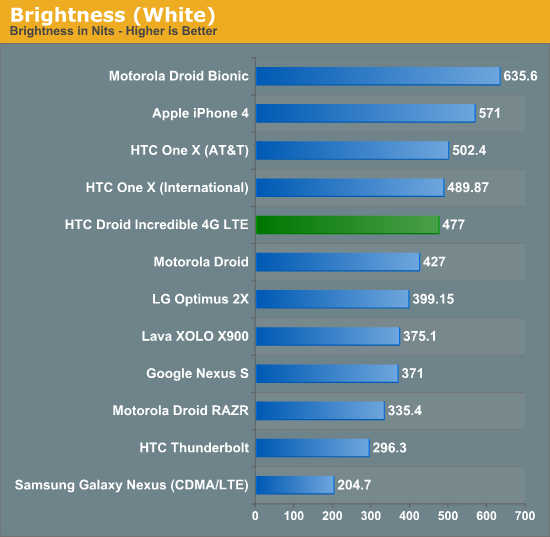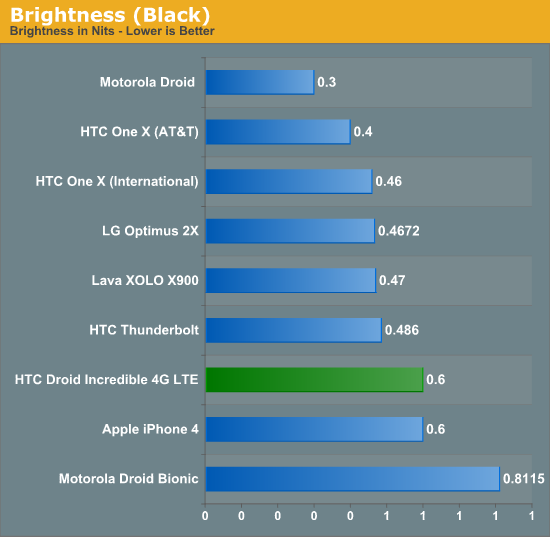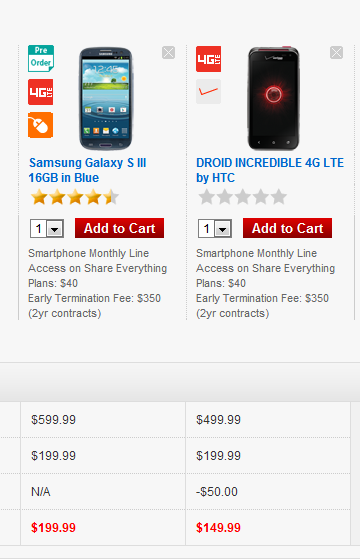Droid Incredible 4G LTE Preview: Is There Room For A 4" Smartphone?
by Jason Inofuentes on July 9, 2012 11:34 AM EST- Posted in
- HTC
- Verizon
- Droid Incredible 4G LTE
I’m working on the Droid Incredible 4G LTE review (there’s a delay resulting from a signal issue where I do battery testing), but in the interim let’s talk about something that seems to have come up about this phone. We don’t often discuss what’s happening on other review sites, even as they get their reviews out much faster than we, but the Incredible 4G LTE has been hit in many reviews for its display, and this surprised me. Let’s take a look at some numbers.
| Anonymized Display Data | |||||
| Contrast Ratio | 951 | 1418 | 746 | n/a | |
| Brightness - White (nits) | 571 | 427 | 484 | 318 | |
| Brightness - Black (nits) | 0.6 | 0.3 | 0.6 | 0 | |
| Stripe | RGB | RGB | RGB | RG,BG | |
|
Panel Technology |
IPS | IPS | IPS |
AMOLED |
|
| Pixel density (ppi) | 330 | 265 | 275 | 305 | |
These charts are our display test data, anonymized so we can do a little experiment. The phone data above includes the iPhone 4S, the Galaxy S 3, the original Motorola Droid and the Droid Incredible 4G LTE. Can you tell which is which? Just take a second. The original Droid was lauded for its IPS display and high pixel density, it was even described in some materials and reviews as ‘large’ at an iPhone besting 3.7 inches. It’s the second one from the left. The Galaxy S 3 is the current king of Android phone displays, and is massive at 4.8 inches, and with an excellent pixel density and picture quality, despite its PenTile roots; it’s the one far to the right. The iPhone 4 premiered with the highest pixel density in a mobile device we’d ever seen, and leveraged its IPS panel for excellent picture quality and viewing angles, and is rarely derided for being small; it’s the one to the far left. That leaves the Incredible 4G whose display isn't being dinged for the data above, but rather being hit for its size and resolution.



The Incredible 4G has better pixel density than the OG Droid (not so far off from the GS 3), is larger than the iPhone by a half an inch, and has excellent colors and viewing angles. So, why does it get so much grief? I’m not sure, but the disdain for it brings us to consider something else: Is there room for a 4” mid-range phone in today’s mobile market?

The sweet spot for cellphones in the US is $199, all thanks to the carrier subsidized model; MSRP’s of $649 are entirely concealed from the consumer, and every phone worth owning exists between $99 and $199. This price compression means that when you’re considering buying a new phone the difference between a mid-range phone and the top-of-the-line ‘halo’ device is usually just $50. Of course, this conceals the reality that the MSRP delta is often upwards of $149. So, how do you make a mid-range smartphone sell in this market? I’m not sure there’s a good answer, but here’s how Verizon is going about it. First they’re using branding that’s familiar to earlier buyers (whose contracts just came-up). Second, they’re including feature and spec deltas that provide a real world experience difference between the mid-range and ‘halo’ devices. Third, they’re not holding back on the advertising. The claims in their advertising are just as bold and brash as in any prior Droid campaign.









_thumb.jpg)
_thumb.jpg)
_thumb.jpg)
_thumb.jpg)
_thumb.jpg)
_thumb.jpg)








37 Comments
View All Comments
s44 - Tuesday, July 10, 2012 - link
The 4.8" phone is actually lighter than the 4" phone, so how much mobility are you really giving up?aliasfox - Tuesday, July 10, 2012 - link
Lighter doesn't mean much if it takes up too much pocket-space to be comfortable.PubFiction - Tuesday, July 10, 2012 - link
Some girls like to be able to fit a phone in their wallets / small purses, they might have physical limit to dimensions. Some people just want a phone to be smaller so it goes more easily into a pocket. Others have larger pockets and would rather just have the extra screen real estate. I think the actual mass of the phone is the feature they are paying too much attention to now. Most people say they want build quality, but then they want it to be light, but last I checked those 2 items oppose each other in most cases.My complaint is just that phones now are compared to others as if there is some perfect size for a phone. How ridiculous would it be to see a review of a 17 inch laptop where the reviewer spent the whole time comparing it to a 13 inch laptop and bitching about the weight, size and lack of back packs for it.
I have seen multiple people buy an iPhone over an android phone simply because it was smaller, and to me that did not make sense. Why didn't any android phones on the high end come with smaller packages.
dishayu - Thursday, July 12, 2012 - link
HTC One S. :)KPOM - Tuesday, July 10, 2012 - link
The best guesses out there are that the next iPhone will have a 4" display. Samsung is by far the dominant Android manufacturer out there (indeed, the largest phone manufacturer), and they have done it with phones with large screens. This tends to invite negative comparisons with phones with smaller screens.doobydoo - Wednesday, July 11, 2012 - link
The thing with Samsung is that they sell their phones cheaper, firstly, meaning people may not be buying just because the screen is bigger, but rather putting up with a bigger more inconvenient screen due to the price saving. Also, while Samsung has a range of phones which add up collectively to more than any other Android manufacturer, not all of those have large screens.The single best selling mobile phone ever is the iPhone 4S, which coincidentally has a smaller form factor. The 'best guesses' out there are that the new iPhone will retain the same or similar form factor, but accommodate a larger screen within it, thus increasing screen size without any sacrifice on mobility or size.
JasonInofuentes - Wednesday, July 11, 2012 - link
Does Samsung sell their phones cheaper? In the US we suffer from the subsidized market which means all our phones end up falling somewhere between $0 and $199, and that includes the iPhone. The more iterative nature of Android has meant, possibly until now, that Samsung needed to shove their phones out of the spotlight quicker to make room for the next big thing, and that often meant giving up the $199 spot. So, while there's no room to argue that the iPhone 4S is the best selling mobile phone, to simply say that Samsung sells its phones cheaper seems specious. Samsung always has a phone, on almost every carrier, that fills that $199 'halo' role.Now, outside of the subsidized market, I don't know. There's a very real possibility that in Europe and Asia the Samsung lines of phones undercut the iPhone's price, but if that's so couldn't it be argued that that's the case for every market Apple competes in? They are always the premium brand. They always charge a higher price than their commodity driven competition. It's what they prefer to do. It's not wrong, it's not right, it's just what they prefer.
Market data told phone manufacturers to move to larger phones a long time ago. The reality is that there are some people who couldn't get used to the small screen of the iPhone, either because their hands were too small or because they just really liked the aesthetics of a big phone. If anyone bought a cheap Galaxy S, or Galaxy S II, or Galaxy Note, because it was cheaper, it was when the device had been sidelined and dropped to $99 on-contract, which means that there was a prior generation iPhone equally priced they could have bought.
JasonInofuentes - Tuesday, July 10, 2012 - link
The PC space is dominated by commoditization. Drive the price of components as low as possible so that anyone with a screwdriver and a dream can make a PC that doesn't completely suck and sell it at a profit. That's dumbing things down a bit, but the cost to build a cheap case for a laptop is easier than for a phone, especially when consumer interest is much more variable. Consumer electronics change styles and fads faster than the fashion industry.And then there's the reality of part scarcity. There's lots of capacity for building 100ish PPI panels in the 10-17 inch space. The capacity for high quality <5" panels with >250ppi isn't nearly so high, and so even if the cost wasn't so great, there'd still be limited supply. And all of this comes, again, from the fact that this is a varying market, and a rapidly growing market. Hundreds of million of handsets get bought every year, not so much laptops.
If innovation in components slows, and OEMs spend more time innovating in packaging, feature set, and, yes, commoditization of components, then they might feel the pressure is off and they can just build different sized handsets and charge differently for them. But is that really fair? I mean should I suffer a slower processor just because I want a smaller phone? I think offering tiered products and varying on glass size without altering price drastically would be the best method.
hags2k - Tuesday, July 10, 2012 - link
Honestly, I think that every manufacturer is going for grand slams instead of base hits. In the PC market, as someone else said, it'd be insanity to offer a laptop in ONLY 17" or ONLY 11", but because companies (*cough*apple*cough*) achieved so much success with ONE model, everyone is trying to duplicate that formula rather than offer consumers some kind of real choice, and on android phones, differentiating yourself is often a matter of one-upsmanship - 4.8 > 4.7 > 4.5 > 4.3 > 4, etc.Eventually they will get wise, I hope, but as the article pointed out, price compression is a factor - with computers, they can sell the same laptop with three screen sizes at three price points, but they don't have that kind of freedom in the US market.
bearxor - Tuesday, July 10, 2012 - link
Remember when the iPhone came out and bucked the trend of increasingly smaller displays? We were down to 2.5" in Windows Mobile devices.